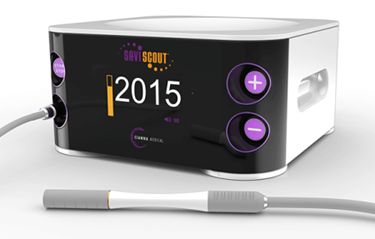New "Antenna-Like" Implant Makes Breast Cancer Surgery Easier

Antenna-like implant can be positioned up to a week in advance and responds to infrared signal during surgery
Breast cancer surgeons routinely face a dilemma: how to find tumors they cannot feel. Before going into the operating room they must use some method to locate them. Currently, the method they use requires a radiologist to insert a device into the woman’s breast. The insert targets the clip that was placed during her biopsy and is placed just prior to surgery, leaving a wire protruding from her breast for the surgeon to follow. The surgeon removes the tumor, device and wire during breast surgery. A new antenna-like device helps surgeons find the tumor they cannot feel and, because it leaves no protruding wires, it also makes surgery easier for women and their breast surgery team.
The new device, called SAVI Scout, is made by Cianna Medical, Inc. and is approved by the Federal Drug Administration. Breast surgeons Stephanie Fine, MD, and Anna Voltura, MD, have started using the device at the University of New Mexico Comprehensive Cancer Center. Like the anti-theft radio frequency tags used in stores, the device acts like an antenna and responds to infrared radio signals. “It does not involve any radioactivity, like the other alternative method to wire localization,” says Fine, “so it does not require nuclear regulatory rules to be in place.”
For the radiologist, inserting the SAVI Scout device is similar to inserting the wired device. For the surgeon, finding the tissue to remove is as easy as turning the device on using a hand-held tool that sends an infrared signal. But for the woman, the SAVI Scout gives her the freedom to go home. “They have nothing protruding externally,” Fine says. “It’s more comfortable and less anxiety-producing. And they can schedule this ‘finder device’ as a separate procedure.” The device can be inserted up to a week before breast cancer surgery.
Completing the insertion procedure well before the surgery allows radiologists to place the device without the risk of delaying surgery. This enables the surgeons to work more efficiently through their operating room procedures on the day of surgery, resulting in fewer delays for their later patients. But best of all, the women and their families can go home between the procedures; they have more time to rest for and relax after their procedures. “We haven’t had any issues,” Fine says of the device. “We are really excited by it.”
About Stephanie Fine, MD
Stephanie Fine, MD, is an Assistant Professor in the Department of Surgery, Division of Surgical Oncology, at the University of New Mexico School of Medicine. She received her medical degree at the UNM School of Medicine and completed her residency and internship at the University of Utah Medical Center. She completed a fellowship in breast surgery at the Akron General Medical Center in Akron, Ohio. Dr. Fine has practiced at community hospitals in Ohio, Utah and New Mexico. She has given numerous presentations on breast cancer. She is a member of the American Society of Breast Surgeons and of the American Society of Breast Disease.
About the UNM Comprehensive Cancer Center
The University of New Mexico Comprehensive Cancer Center is the Official Cancer Center of New Mexico and the only National Cancer Institute-designated Cancer Center in a 400-mile radius. One of the premier cancer centers nationwide, the UNM CCC has 128 board-certified oncology physicians, forming New Mexico’s largest cancer care team. It treats about 60 percent of adults and virtually all the children in New Mexico diagnosed with cancer — more than 10,000 people— from every county in the state in more than 135,000 clinic visits each year. Through its partnership with the New Mexico Cancer Care Alliance, an “exemplary national model for cancer health care delivery,” the UNM CCC offers access to more than 160 clinical trials to New Mexicans in every part of the state. Annual research funding of more than $72 million supports the UNM CCC’s 132 cancer scientists. Working with partners at Los Alamos and Sandia National Laboratories, Lovelace Respiratory Research Institute, and New Mexico State University, they have developed new diagnostics and drugs for leukemia, breast cancer, ovarian cancer, prostate cancer, liver and pancreatic cancer, brain cancer, and melanoma; garnered 33 new patents and 117 patents pending; and launched 13 new biotechnology companies since 2010.
Source: University of New Mexico Comprehensive Cancer Center
